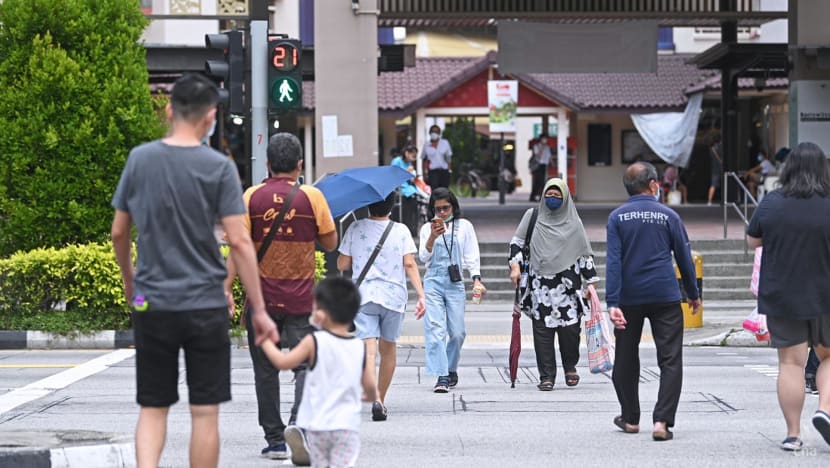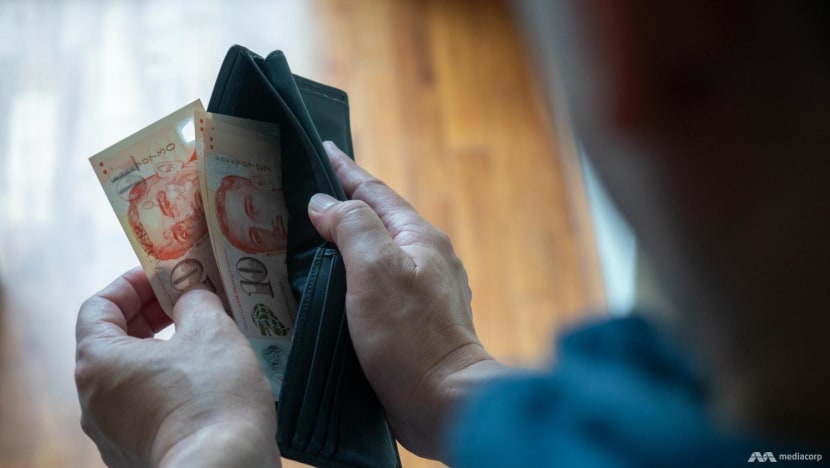Commentary: Not clear that there is a better time to raise GST
The rising cost of living is squeezing Singaporeans, but there might not be a better time for the GST hike when inflation will likely persist, says the Lee Kuan Yew School of Public Policy’s Terence Ho.

People wearing face masks cross a road in Tampines in Singapore on Feb 25, 2022. (Photo: CNA/Gaya Chandramohan)
SINGAPORE: The passing of the Goods and Services Tax (Amendment) Bill in Parliament on Monday (Nov 7) has finally set in motion the long-anticipated GST hike. Announced some four and a half years ago, it will increase from 7 per cent to 8 per cent from Jan 1, 2023, and from 8 per cent to 9 per cent from Jan 1, 2024.
The path here has been anything but straightforward. First, the COVID-19 pandemic struck in 2020, with the economic fallout extending into 2021. Then, inflation climbed towards a 14-year high in 2022 on the back of global supply disruptions and a recovery in demand.
Still, there was a vigorous five-hour debate in Parliament on Monday, with Opposition MPs calling for a deferral of the GST increase while inflation remains high.
Rising inflation has indeed put a squeeze on Singapore households, especially with prices rising in food and energy.
Even if one accepts that the GST rise is necessary to put Singapore on a sound fiscal footing for the future, in view of growing government expenditure, would there be a better time for it? It is not clear that there is.
RAISE GST NOW OR LATER?
One option that has been mooted is to defer the hike for a decided duration – say six months, a year or more. A dynamic version would have been to peg it to inflation falling to a target rate.
However, inflation will likely remain elevated for some time to come. Even without the GST hike, headline inflation is forecast to be between 4.5 per cent to 5.5 per cent in 2023, compared with an average of 1.5 per cent in the decade before 2020. An escalation of the war in Ukraine or other disruptions to global supply chains could see prices rise even faster.

To keep inflation under control, the United States Federal Reserve is expected to continue raising interest rates in 2023. Fed chairman Jerome Powell said on Nov 2 that it was still “very premature” to think about pausing interest rate increases, following the sixth consecutive rate hike this year.
The tightening of monetary policy has slowed economic growth in the US and across the world, elevating the risk of a full-blown recession. Powell himself has acknowledged that the chances of a “soft landing” were diminishing as price pressures have proved persistent.
Taking the first step to raise GST when Singapore’s labour market is still tight and nominal wage growth is robust may be preferable to having to raise it when market conditions are weaker.
GOVERNMENTS MUST CONTINUE TO SPEND
What is clear, however, is that the GST hike cannot be put off for too long if Singapore’s public finances are to be kept on an even keel.
The financial turmoil following the United Kingdom government’s recent “mini-budget” – which ultimately led to Liz Truss stepping down as prime minister after just 44 days in office - illustrates how swiftly the markets can punish even a major advanced economy for shortcomings in fiscal discipline.
With billions proposed in tax cuts without similar cuts in public spending, which would then require substantially greater borrowing, the mini-budget sent the British pound plunging and sparked a sell-off in the UK government’s bonds, known as gilts.
Slower growth and higher interest rates will make it harder still for governments to increase borrowing to fund current expenditure or risk having to cut back public services.
While Singapore’s public finances are in a far less parlous state, the fact remains that spending has been rising rapidly. One of the main drivers is higher spending on healthcare as the population ages.
Public healthcare expenditure has jumped from S$2.2 billion in FY2007 (when GST was last raised) to S$18.4 billion in FY2021. It is projected to rise further to some S$27 billion by 2030. Since FY2020, government spending on healthcare has overtaken education spending and even on defence.
MORE EQUITABLE, INCLUSIVE SOCIETY
What is perhaps less well appreciated is the need for higher government revenues and expenditure for a more equitable and inclusive society and how GST directly contributes to this. Around half of GST revenues are collected from tourists and foreigners residing here, with higher-income Singaporeans also contributing a significant portion.
On the other hand, the GST voucher scheme targets assistance to lower and middle-income Singapore households. Enhancements to the scheme announced this year will fully offset total GST – not just the increase – for retiree households living in one- to four-room HDB flats.
The Government’s Assurance Package also helps offset the GST hike impact on lower-income households for 10 years, and for the majority of Singaporean households for at least five years. This means the GST increase is, in practice, deferred for five to 10 years for many Singaporeans.Notably, GST, or value-added tax (VAT), is a vital component in the fiscal system of advanced economies, such as Denmark, Norway and Sweden, where VAT is as high as 25 per cent.
While it may not be Singapore’s intent to emulate these countries in terms of tax burden, there will be a need for greater social support to help with the rising cost of living. To sustain social mobility for the young, fiscal transfers will also be used to offset the advantages of wealth, opportunities and networks that the more affluent are able to pass on to their children.
A BALANCED FISCAL APPROACH
GST is not the only revenue stream Singapore is drawing more from. A balanced fiscal approach cannot rely heavily on just one or two taxes.
In recent years, wealth taxes have been raised in the form of more progressive property taxes. The top marginal personal income tax rate was raised from 20 per cent to 22 per cent for income earned in 2016 and is set to rise further to 24 per cent for income earned in 2023.
Rules have also been changed to allow the government to draw considerably more income from the investment returns on past reserves for current expenditure needs. For a more equitable distribution of the cost burden over time, the Government passed the Significant Infrastructure Government Loan Act to allow borrowing for long-term infrastructure.
GST is important as a broad-based consumption tax which is difficult to evade and has the advantage of efficiency in collection and administration. However, the additional S$3.5 billion that is expected to be netted each year from the GST increase will not be enough to offset higher public expenditure if the latter continues its rapid ascent.
Hence, other revenue streams will have to continue to be strengthened in the years ahead. Just as important is to ensure prudent expenditure, to gain maximum value from each tax dollar spent.
It will take financial prudence and forward planning on the part of both citizens and the state to keep household and state balances healthy in an uncertain and volatile world.
Terence Ho is Associate Professor in Practice at the Lee Kuan Yew School of Public Policy. He is the author of Refreshing the Singapore System: Recalibrating Socio-Economic Policy for the 21st Century (World Scientific, 2021).


















